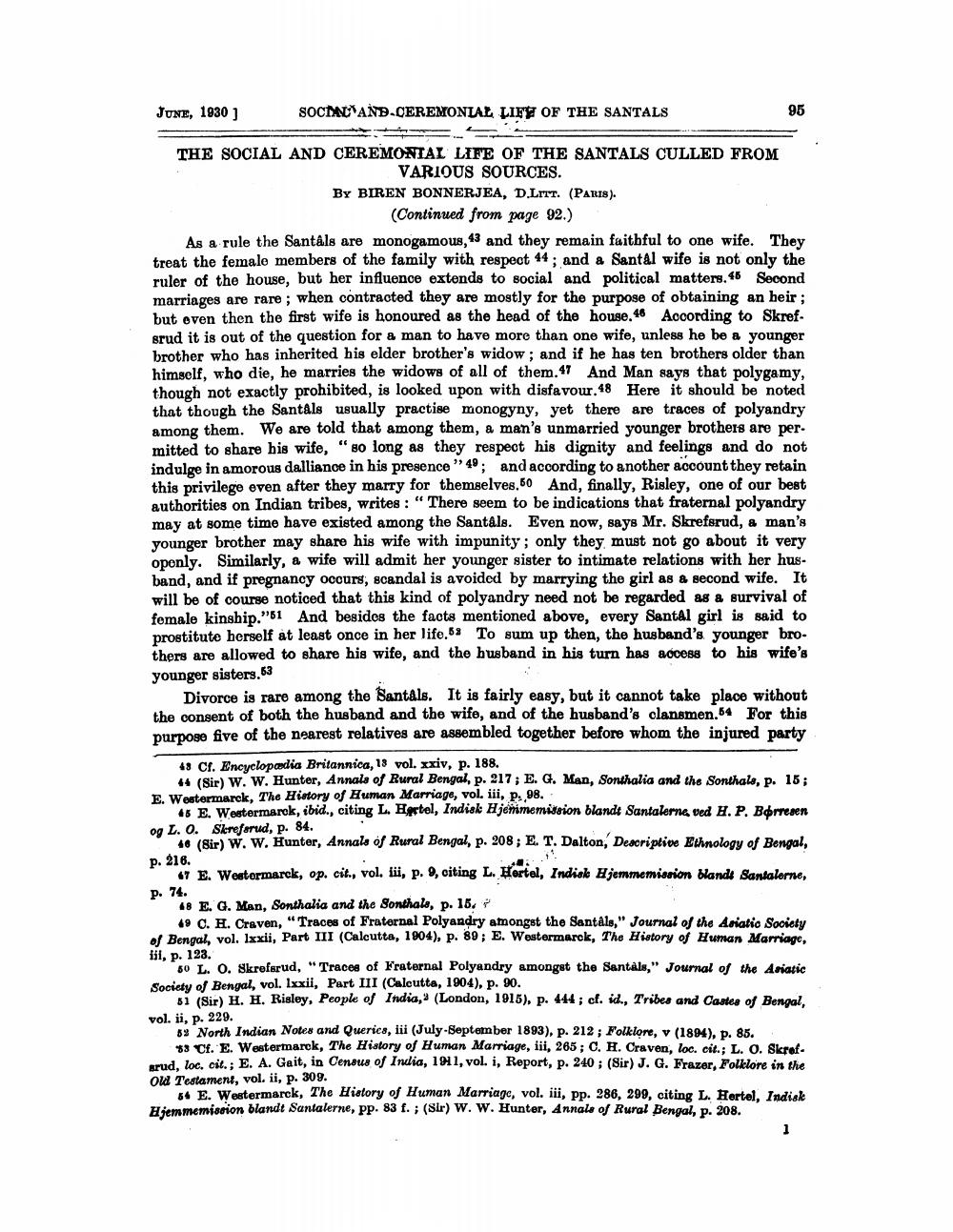________________
JUNE, 1930]
SOCIAVAND-CEREMONIAL LIFY OF THE SANTALS
95
THE SOCIAL AND CEREMONIAL LIFE OF THE SANTALS CULLED FROM
VARIOUS SOURCES. BY BIREN BONNERJEA, D.LITT. (PARIS).
(Continued from page 92.) As a rule the Santals are monogamous, 43 and they remain faithful to one wife. They treat the femalo members of the family with respect 44 ; and a Santal wife is not only the ruler of the house, but her influence extends to social and political matters. 46 Second marriages are rare; when contracted they are mostly for the purpose of obtaining an heir ; but even then the first wife is honoured as the head of the house. 46 According to Skref srud it is out of the question for a man to have more than one wife, unless he be a younger brother who has inherited his elder brother's widow; and if he has ten brothers older than himself. who die, he marries the widows of all of them.47 And Man says that polygamy, though not exactly prohibited, is looked upon with disfavour.48 Here it should be noted that though the Santals usually practise monogyny, yet there are traces of polyandry among them. We are told that among them, a man's unmarried younger brothers are per mitted to share his wife," so long as they respect his dignity and feelings and do not indulge in amorous dalliance in his presence" 49; and according to another account they retain this privilege even after they marry for themselves,60 And, finally, Risley, one of our best authorities on Indian tribes, writes : " There seem to be indications that fraternal polyandry may at some time have existed among the Santals. Even now, says Mr. Skrefsrud, a man's younger brother may share his wife with impunity; only they must not go about it very oponly. Similarly, a wife will admit her younger sister to intimate relations with her husband, and if pregnancy occurs, scandal is avoided by marrying the girl as & second wife. It will be of course noticed that this kind of polyandry need not be regarded as a survival of female kinship."'51 And besides the facts mentioned above, every Santal girl is said to prostitute herself at least once in her life.68 To sum up then, the husband's younger brothers are allowed to share his wife, and the husband in his turn has access to his wife's younger sisters.63
Divorce is rare among the Bantals. It is fairly easy, but it cannot take place without the consent of both the husband and the wife, and of the husband's clansmen.54 For this purpose five of the nearest relatives are assembled together before whom the injured party
48 Cf. Encyclopædia Britannica, 18 vol. xxiv, p. 188.
44 (Sir) W. W. Hunter, Annals of Rural Bengal, p. 217; E. G. Man, Sonthalia and the Sonthale, p. 15; E. Westermarck, The History of Human Marriage, vol. iii, p. 98.
45 E. Westermarok, ibid., citing L, Hartel, Indisk i jemimemission blandt Santalerne ved H. P. Bornesen og L. O. Streforud, p. 84.
46 (Sir) W. W. Hunter, Annals of Rural Bengal, p. 208; E. T. Dalton, Descriptive Ethnology of Bengal, p. 216. * 47 E. Westermarck, op. cit., vol. iii, p. 9, citing L. Hertel, Indisk Hjemmemission blandt Santalerne, p. 74.
48 E. G. Man, Sonthalia and the Sonthals, p. 15.
49 C. F. Craven, "Traces of Fraternal Polyandry amongst the Santals," Journal of the Asiatic Society of Bengal, vol. lxxii, Part III (Calcutta, 1904), p. 89; E. Westermarck, The History of Human Marriage, isl, p. 123.
80 L. O. Skrefsrud, "Traces of Fraternal Polyandry amongst the Santals," Journal of the Asiatic Society of Bengal, vol. lxxii, Part III (Calcutta, 1904), p. 90.
si isir) H. H. Risley, People of India, (London, 1915), p. 444; cf. id., Tribes and Castes of Bengal, vol. ii, p. 229.
59 North Indian Notes and Querica, iii (July-September 1893), p. 212; Folklore, v (1894), p. 85.
43 Cf. E. Westermarck, The History of Human Marriage, iii, 265; C. H. Craven, loc. cit.; L. O. Skrof. krud, loc. cit.; E. A. Gait, in Census of India, 1911, vol. i, Report, p. 240 ; (Sir) J. G. Frazer, Folklore in the Old Testament, vol. ii, p. 309.
54 E. Westermarck, The History of Human Marriage, vol. iii, pp. 286, 299, citing L. Hertel, Indisk Hiem memianion blandt Santalerne, PP. 83 f. ; (Sir) W. W. Hunter, Annals of Rural Bengal, p. 208.




